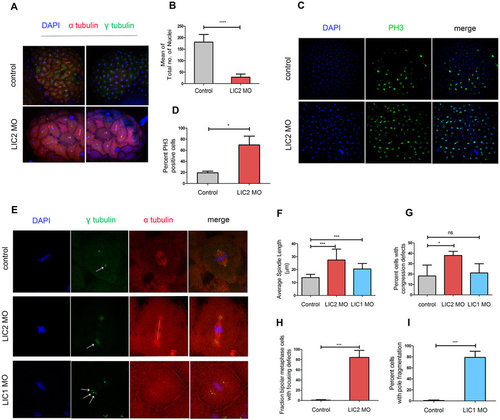- Title
-
The Light Intermediate Chain 2 Subpopulation of Dynein Regulates Mitotic Spindle Orientation
- Authors
- Mahale, S., Kumar, M., Sharma, A., Babu, A., Ranjan, S., Sachidanandan, C., Mylavarapu, S.V.
- Source
- Full text @ Sci. Rep.
|
Zebrafish LIC2 is required for early embryonic development. (A) zLIC2 expression at early stages of zebrafish embryogenesis, as shown by immunoblotting of whole embryo lysates. (B) zLIC1 expression at early stages of zebrafish embryogenesis, as shown by real time PCR analysis. (C) Knockdown of zLIC2 in zebrafish embryos. Top–control embryos as indicated. Below–depletion of zLIC2 by zLIC2-specific morpholinos as indicated. (D) Fraction of embryos showing the furrow phenotype. (E) Western blot showing zLIC2 knockdown using translation blocker LIC2 MO (the top zLIC2 band completely disappears upon MO treatment). β-actin serves as loading control. (F) Reverse transcriptase PCR showing splice variants in LIC2 splice morpholino injected embryos (arrows). Lane 1 = molecular weight ladder. (G) Gross embryo morphology (top) and phosphohistone 3 staining (bottom) of embryos injected with LIC2 morpholino and/or rLIC2 mRNA as indicated. (H) Fraction of cells in metaphase from morphants, rescued and mRNA injected embryos from G. N = 17, 28 and 20 embryos respectively from 2 experiments. (I) Representative embryo injected with 5 ng translation blocker MO against zLIC2 show developmental delays at 1 dpf. |
|
Zebrafish LIC2 depletion leads to mitotic defects in early embryonic divisions. (A) Cytology of blastomeres upon LIC2 depletion. Each representative image shows the top surface view of the embryo at 3.3 hpf, recreated from confocal z-stacks. Control = embryos injected with standard control MO. Embryos are stained for microtubules (red), centrosomes (green) and chromosomes (blue). (B) Total average number of nuclei per embryo in surface blastomeres of time-matched embryos (minimum 3 experiments, n = 10 control and 23 LIC2 depleted embryos). (C) Sum projections of confocal z stacks showing mitotic cells labelled with phosphohistone 3 (PH3, green) and chromatin (DAPI, blue). (D) Fraction of PH3 positive cells upon respective treatment. N = 23 and 15 embryos respectively for uninjected and LIC2 MO treatment from 2 experiments. (E) Confocal images of surface blastomeres showing longer mitotic spindles (white dotted line), control and unfocused spindle poles (white arrows) and fragmented spindle poles (multiple white arrows) in zLIC1 and zLIC2 morphants. Chromosomes (DAPI, blue), spindle poles (γ-tubulin, green) and microtubules (α-tubulin, red) are immunostained as indicated. (F) Average spindle length in surface blastomeres. n = 139 control cells (30 embryos), 118 metaphase cells for LIC2 depletion (26 embryos) and 52 metaphase cells (10 embryos) for LIC1 depletion, across a minimum 3 experiments each. (G) Fraction of blastomeres showing chromosome congression defects from the embryos in F. (H) Fraction of blastomeres showing spindle pole focusing defects upon LIC2 depletion. n = 69 control metaphase cells (12 embryos) and 95 metaphase cells (16 embryos) across a minimum of 3 experiments each. (I) Fraction of blastomeres showing spindle pole fragmentation upon LIC1 depletion. n = 52 metaphase cells (10 embryos) across 3 experiments. Error bars are mean +/− SD. PHENOTYPE:
|


